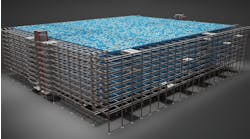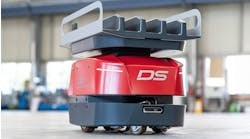Virtual reality (VR) has made a dent in gaming, but its real value is in commercial and industrial environments. Improved graphics, lighter-weight goggles, and better software along with lower costs will make VR solutions ubiquitous across many arenas.
One area where VR is coming into its own is in training. VR allows training to be more interactive as well as putting users in situations that might otherwise be unsafe or hard to replicate in the real world. Oftentimes, training has consisted of books and Powerpoint presentations with minimal on-the-job training.
Royal Innovative Solutions (RIS) is one company that’s working to bring VR to the highways. Their VR training solutions targeting highway safety and construction help reduce lost time from injuries and minimize litigation costs related to working in hazardous environments (Fig. 1). The training environment uses a combination of VR and 3D animation. The VR approach boosts learning and retention rates.
1. Royal Innovation Solutions is leveraging VR for training purposes.
The ability to rehearse operations in a realistic environment can lead to increased operational efficiency and production as well. Furthermore, RIS is bringing training to many states where highway safety training was minimal or non-existent due to the costs and the ineffectiveness of book learning. VR also allows training to be done almost anywhere.
Another area where VR is having a major impact is in drone technology. Drone racing, like the International Drone Racing Association competitions, has participants piloting drones at very high speeds through flight mazes.
A more practical tool is the DJI Goggles from DJI for their complement of consumer and commercial drones (Fig. 2). The VR headset is integrated with the flight control and camera system. It provides 1080p resolution to both eyes with an 85-deg. field of view. The drones can transmit at that resolution when the headsets are nearby and at 720p over longer distances. Up to four users are able to share the experience from a single drone.
2. The DJI Goggles can be used for flight control and/or camera control. Multiple users are able to view the camera video at the same time.
A touchpad on the right side of the goggles can be used for command and control. It’s also possible to use head tracking for control of the camera or the flight. Flight control and camera control are split; therefore, a pilot can handle flight control while other users view or control the camera. This can make tracking an object easier since a pilot doesn’t have to worry about the drone movement as well as the camera movement. Head tracking makes camera movement very simple and natural.
The DJI drones have a number of flight control modes that blend well with VR. The simulated fixed wing mode allows a drone to act like a plane that flies at a constant speed. The VR headset movement is used to adjust yaw and pitch. There’s also terrain following and a tripod mode that allows users to concentrate on camera movement.
The DJI Goggles are designed for drones compared to the conventional VR glasses. Antennas are built into the headband and it’s balanced for head movement. The headset can flip up or be easily removed to provide viewing of the outside world. The touchpad is a useful addition and can be easily disabled. The system also has an HDMI input for external video feeds.
VR is being used in other applications, from car showrooms to present the latest model cars and trucks to virtual vacations for exploring venues without leaving home. The 1080p resolution is currently the norm, with 4K and higher pushing the envelope in cost and performance. These are also pushing the GPUs driving the systems because of the higher bandwidth.














